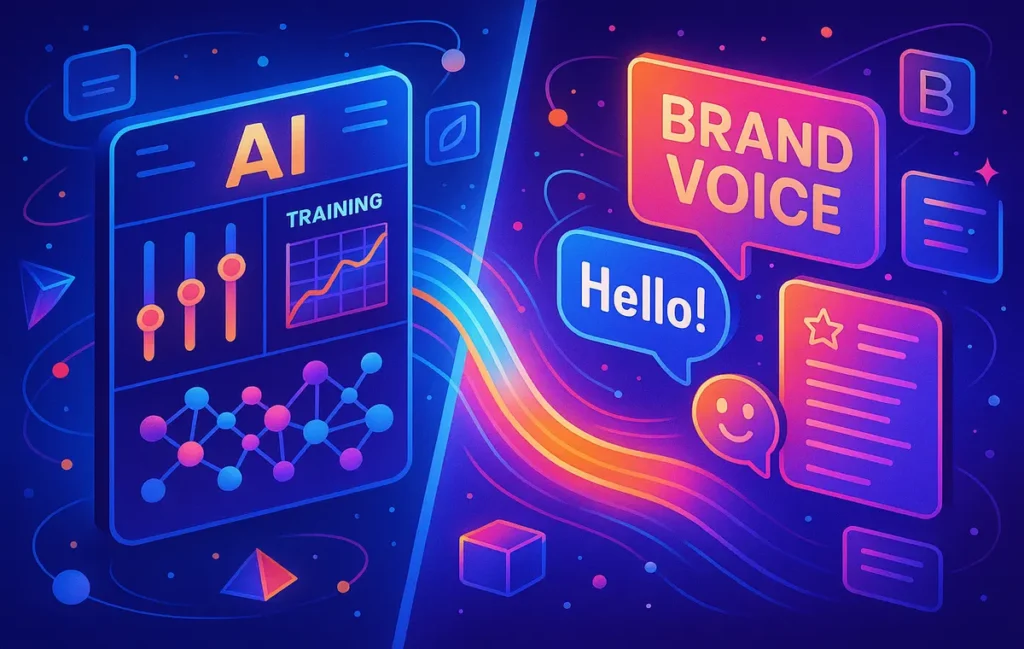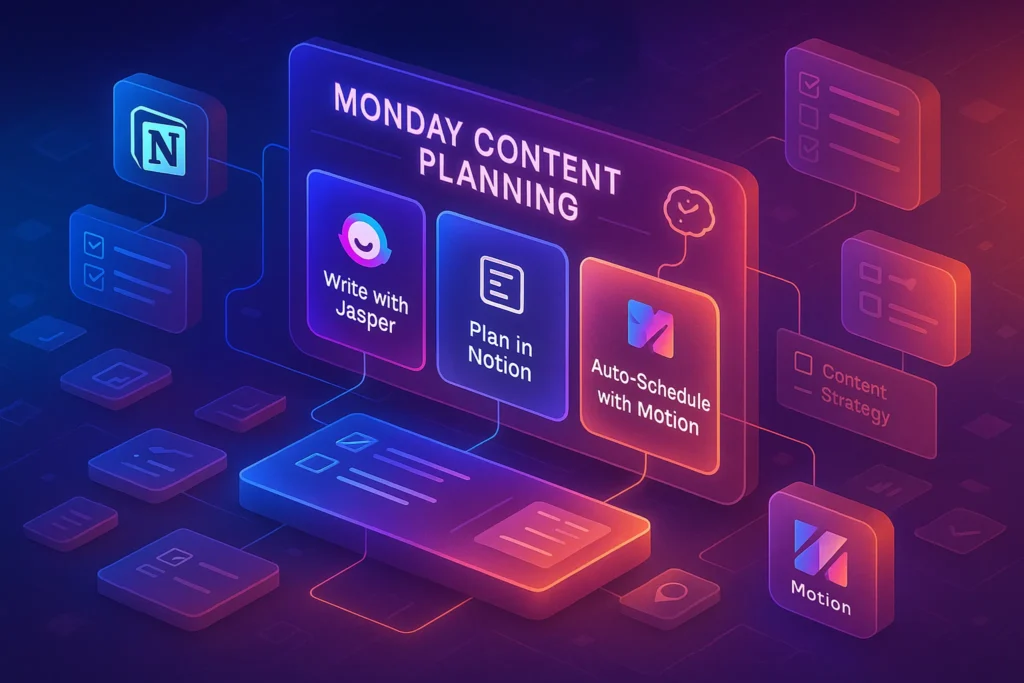🎯 Why Brand Voice Consistency Matters in 2025
In 2025, the digital content landscape is more crowded than ever. Brands are competing across dozens of platforms, from long-form blogs to TikTok microcopy, and the one thread that separates strong brands from forgettable ones is voice consistency. A reader who sees your brand on LinkedIn should instantly feel the same personality they’d encounter in your email newsletter or blog.
The challenge? Maintaining that consistency when much of your content pipeline is supported—or even powered—by AI. Tools like Jasper, Copy.ai, Writesonic, and Notion AI are efficient, but they don’t inherently “know” your brand voice unless you train them. If left unshaped, AI often defaults to generic, flat, or overly promotional tones. This is where structured brand voice training steps in: a process that ensures AI-generated output feels authentically yours.
💡 Nerd Tip: Think of AI tools as new interns. They’re fast, tireless, and capable—but they won’t represent your brand well unless you invest time in their onboarding.
📝 Step 1: Define Your Brand Voice Profile
The first step is clarity. Before AI can mirror your tone, you must be crystal clear about what that tone is. This isn’t just about adjectives like “friendly” or “professional.” It’s about building a multidimensional voice profile that includes tone, vocabulary, and persona.
For example, a fintech startup might define its voice as “trustworthy, data-driven, empathetic to customer concerns, using simple but precise vocabulary.” By contrast, a gaming blog might lean toward “bold, playful, slightly rebellious, with a vocabulary rich in pop culture and insider humor.”
To capture this systematically, many teams create brand voice charts or persona sheets. These documents don’t just tell writers what to do; they give AI a training reference. Jasper, Copy.ai, and Writesonic allow you to input this context directly, ensuring every prompt begins with a brand-aware foundation.
A practical method is to select three adjectives for tone, three for vocabulary, and one core metaphor for your persona. Example: “Tone: empowering, approachable, curious. Vocabulary: tech-savvy, precise, modern. Persona: like a mentor who’s always up-to-date but never condescending.”
🤖 Step 2: Train the AI Tool
Once you have a clear voice profile, it’s time to embed it into the AI. Most copywriting platforms now offer brand-specific training modes. Jasper has “Brand Voice” uploads, Copy.ai provides tone instructions, while Notion AI lets you prime context with long prompts.
Here’s how it works:
-
Input your brand voice profile into the AI as an evergreen prompt.
-
Feed it sample content (previous blog posts, product descriptions, newsletters).
-
Reinforce the rules: tone, vocabulary, formatting preferences, and even what not to do.
For example, if your brand avoids jargon, tell the AI: “Never use terms like ‘synergy’ or ‘paradigm shift.’ Always use plain English.” Over time, the model starts internalizing your preferred phrasing.
💡 Nerd Tip: Don’t treat AI training as a one-time upload. Revisit and refine as your brand voice evolves, just like you’d refresh a style guide.
🧪 Step 3: Test the Output in Real Scenarios
Training isn’t complete until you see how the tool performs in the wild. Create a controlled test environment: blog intros, social captions, ad copy, and email subject lines. Compare them against human-written benchmarks.
This is where you often see the “before and after” difference. Before training, AI outputs tend to be bland and generic: “Unlock your business potential with our innovative solutions.” After training, the same prompt might yield: “Cut through the noise. With tools designed for creators, NerdChips helps your best ideas travel further.”
The difference is striking—one feels like filler; the other feels branded, alive, and audience-focused.
At this stage, it’s useful to involve your marketing team. Collect feedback not just on grammar or tone, but emotional resonance. Does the copy sound like you?
🔄 Step 4: Iterate and Maintain Consistency
Brand voice is never static. It evolves with your audience, industry, and even culture shifts. AI tools need continuous calibration. For instance, if your brand pivots to a more sustainability-driven narrative, you’ll need to update prompts and training datasets accordingly.
Iteration is also essential for catching AI drift. Over time, AI can slip back into generic habits, especially if you use it across different campaigns. Regular audits keep your output sharp.
One practical strategy: every quarter, run a voice consistency audit. Take 10 pieces of AI-generated content across platforms and compare them to your brand profile. Score them on a 1–5 scale for alignment. This discipline ensures your copywriting remains consistent, whether you’re writing a long-form blog on AI Blog Writers or a quick campaign ad.
💡 Nerd Tip: Schedule consistency audits just like financial reviews. They may not feel urgent, but they save you from costly brand dilution.
⚠️ Pitfalls and Limits of AI Training
While AI copywriting tools are powerful, they come with limitations. The most common pitfall is over-simplification. AI often strips nuance from complex ideas. A healthcare brand, for instance, may find that trained AI copy glosses over regulatory subtleties.
Another risk is AI drift. Even with training, AI may occasionally hallucinate facts, leading to credibility issues. This is particularly dangerous for industries like finance or medicine. A real-world case in 2024 saw an AI-generated investment blog confidently citing non-existent research papers—an embarrassing incident that damaged brand trust.
There’s also the challenge of scalability. Training Jasper or Writesonic for one campaign is manageable, but scaling across hundreds of touchpoints requires rigorous documentation and consistent oversight.
Finally, remember that AI is a partner, not a replacement. While it can amplify productivity, it doesn’t replace the need for human editors who safeguard nuance, ethics, and cultural awareness. As explored in our AI vs Human Creativity article, the best results often come from hybrid collaboration.
📊 Mini-Comparison: Jasper vs Copy.ai vs Notion AI
| Tool | Strength in Brand Voice Training | Weakness | Best Use Case |
|---|---|---|---|
| Jasper | Robust brand voice uploads, long-form friendly | Can become formulaic over time | Enterprise teams scaling blogs & ads |
| Copy.ai | Fast ideation, great at varied tone experiments | Limited deep context memory | Quick campaigns & social content |
| Notion AI | Flexible prompts within workflow docs | Less specialized than Jasper/Copy.ai | Teams embedding AI in daily collaboration |
💡 Nerd Tip: Test across multiple tools, then standardize. Many teams discover that one tool excels at blog content while another shines at ad copy.
🔗 Learning Paths
For deeper dives, our guides on Best AI Writer Tools for Digital Marketers, Best AI Writing Tools for Bloggers, and The Future of Content Creation expand on choosing the right platform. Each complements the brand voice framework by offering tool-specific strategies.
⚡ Ready to Build Smarter Workflows?
Explore AI workflow builders like HARPA AI, Zapier AI, and n8n plugins. Start automating in minutes—no coding, just creativity.
📂 Real-World Case Study: From Generic to On-Brand
In late 2024, a SaaS startup in the B2B collaboration space faced a common problem: their AI-generated emails and landing pages sounded flat and robotic. Although the content was grammatically perfect, customer feedback revealed that it “felt like any other SaaS company” and lacked personality.
The team decided to systematically train Jasper with their brand voice. They uploaded 50+ examples of human-written newsletters, refined their tone descriptors (“professional yet approachable, confident but not arrogant”), and added explicit negative rules (“never use clichés like ‘unlock your potential’ or ‘synergy’”).
The results were measurable within two months. Their email click-through rate increased by 18%, and time-on-page for blog articles rose by 12%. Most importantly, qualitative surveys showed customers describing the brand as “helpful” and “human”—a noticeable shift from the “generic tech company” perception.
💡 Nerd Tip: Numbers matter, but perception drives brand equity. Pair quantitative gains (CTR, engagement) with qualitative shifts in how your audience talks about you.
📊 Measuring Success: KPIs for AI-Trained Brand Voice
Training AI for brand voice isn’t complete unless you can measure its effectiveness. Without clear metrics, you risk relying on “gut feel” and missing subtle drift. Here are three layers of KPIs to track:
1. Consistency Metrics:
Run quarterly audits where human reviewers score AI-generated texts against your brand voice profile. Use a 1–5 scale across tone, vocabulary, and persona alignment. This provides a tangible “Consistency Score” to monitor progress.
2. Engagement Metrics:
Look for changes in CTR (click-through rate), average read time, bounce rates, and conversions. If your AI-trained voice resonates, readers will stay longer, click more, and interact more deeply.
3. Feedback Loops:
Collect qualitative data through surveys, customer interviews, or even social listening. If people start echoing your brand’s key phrases or tone (e.g., “This email felt like it was written for me”), it’s a sign the AI is hitting the mark.
💡 Nerd Tip: Don’t just measure outputs (words written). Measure outcomes (audience response). That’s the real test of brand voice alignment.
🌍 The Cultural & Ethical Dimension
AI may master your tone in one market but misfire in another. Cultural sensitivity is a crucial, often overlooked, part of brand voice training. For instance, humor that feels engaging in the U.S. might be interpreted as disrespectful in Japan. Similarly, direct sales language that works in Western markets can feel aggressive in parts of Asia or the Middle East.
Another ethical dimension is bias. AI trained on biased datasets might subtly reflect stereotypes in its word choices. A wellness brand found its AI tool defaulting to female pronouns when writing about yoga and male pronouns when describing strength training—an unintentional but problematic pattern.
To prevent these missteps, global brands often build “cultural filters” into their brand voice documents. This means explicitly stating what’s off-limits, such as insensitive jokes, regionally taboo terms, or over-generalizations. Some companies even maintain separate micro-voice profiles for different geographies.
💡 Nerd Tip: Treat AI like an eager writer who doesn’t understand context. You need to spell out not just how to write, but also where not to cross cultural lines.
🚀 Future Trends: Where Brand Voice Training Is Headed
Looking ahead, brand voice training with AI will only grow more sophisticated. Three emerging trends stand out:
1. Fine-Tuned Brand Models:
Instead of training general tools like Jasper with prompts, companies are beginning to fine-tune dedicated LLMs exclusively on their brand’s content. This means an AI model that literally “thinks in your brand’s voice” at all times.
2. Real-Time Adaptive Voice:
Expect AI to dynamically shift tone based on platform. The same core brand voice will be presented more formally in a LinkedIn post, more playful in a TikTok caption, and more authoritative in a whitepaper—without requiring separate manual prompts.
3. Sentiment-Aware Copywriting:
Future tools will incorporate sentiment analysis, adjusting brand voice not only for tone but for emotional resonance. Imagine AI that notices customer frustration in support tickets and auto-shifts to a more empathetic, calming voice.
These trends point toward a future where AI isn’t just mimicking your brand voice but becomes an embedded, real-time brand guardian. For content creators, staying ahead of this curve means treating brand voice as a living asset, not a static guideline.
💡 Nerd Tip: Don’t wait for the future to arrive. Start small experiments now—test adaptive tone on different platforms, or build a mini dataset of your best-performing branded copy for fine-tuning.
📬 Want More Smart AI Tips Like This?
Join our free newsletter and get weekly insights on AI tools, no-code apps, and future tech—delivered straight to your inbox. No fluff. Just high-quality content for creators, founders, and future builders.
🔐 100% privacy. No noise. Just value-packed content tips from NerdChips.
🧠 Nerd Verdict
AI-powered brand voice training isn’t just a technical process; it’s a cultural commitment. The tools are capable, but the responsibility rests on the humans guiding them. The brands that win in 2025 won’t be those who use AI the fastest, but those who use it the most thoughtfully—embedding voice, personality, and authenticity into every touchpoint. For creators and teams who want their content to stand out, consistency isn’t optional. It’s survival.
❓ FAQ: Nerds Ask, We Answer
💬 Would You Bite?
How confident are you that your current AI tools truly reflect your brand voice?
Would you trust them to write your next homepage? 👇
Crafted by NerdChips for creators and teams who want their best ideas to travel the world.



